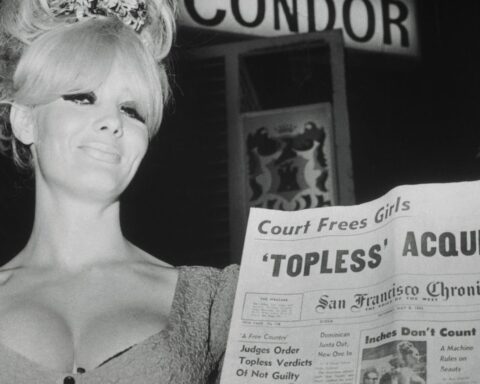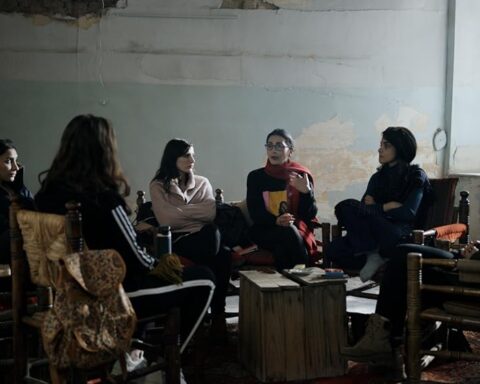A large roomful of incredible women converged at Simon Fraser University for three days in October. Leaders of industry, government and labour sat down with filmmakers, broadcasters, academics, new-media designers, engineers and students to ask a question that seems to have fallen off the agenda: where are the women? For while there is a clear female presence at the top of media organizations, government funding bodies and labour unions, the employment numbers for women drop off precipitously in emerging new-media industries and there is a disastrous—and wasteful—exodus at mid-career in most areas.
In her keynote address, Rosalind Gill laid out the situation. As media industries become increasingly privately owned—and non-unionized—they also become more male-dominated and less ethnically diverse, operating according to an exclusive and “laddish” network. Gill diagnoses a new sexism at play, one marked by disclaimers (“I’m a strong supporter of women, but we can’t possibly accommodate those family demands”; “I’m all for creating more diverse representations of women, but the sponsors don’t want it,” etc.). Women still make up only a minority of key creative roles in the film industry (less than 20 per cent) and on-screen, there have been what can only be seen as serious setbacks for the representation of women to the point that today, women comprise less than 30 per cent of speaking characters in the mainstream media.
The pornography industry has grown at an astounding pace and depictions of violence against women are prominent across genres. Video gaming, the fastest growing sector of the media industry, has a workforce and audience composed almost exclusively of men. And, given that the mainstream media’s emphasis is on youth and beauty as women’s most important attributes, the representations that are out there aren’t all that diverse or inspiring.
Partly, these figures reflect the fact that some of the pressure that used to be placed on professional media for fair and equitable representation has been relaxed as YouTube and other video-sharing sites are held out as the realization of the participatory culture once sought by feminist critics. Yet as keynote speaker Alexandra Juhasz noted, YouTube continues to structure what is seen and unseen, said and unsaid, in many ways that are continuous with corporate media practices of the past. Not least is the fact that the vast majority of YouTube videos are either clips from—or appreciative mashups of—corporate culture. In fact, it was suggested on numerous occasions that women’s desires to participate in the digital economy are increasingly channelled into unremunerated work on amateur social networks, such as “mommy blogs,” while simultaneously being all but excluded from the professional ones.
Most worrisome, perhaps, is the rise of a post-feminist culture that denies the need for transformative politics. That, along with the absence of a visible feminist politics, has led to a veritable hijacking of women’s issues by the right. In the United States, discourses around women as passive victims are routinely presented to perpetrate acts of military aggression, and the emergence of Tea Party–style moms-in-chief, who appeal to essentialist arguments about the fundamental differences between women and men, serves to reinforce reactionary visions of the family and society. The variety of forces that have made many women of all ages resistant to using feminist discourse—whether the internalized emphasis on individual responsibility, the experience of repercussions, or simply the burn-out—has led to a resounding silence about structural gender inequality.
Three years in development, the conference was organized by a dedicated team at SFU (Simon Fraser University) headed by Rina Fraticelli, the film producer who brought us the NFB project Five Feminist Minutes over 20 years ago. Fraticelli brought an astounding array of people together to get to the bottom of the problem no one seems to be looking directly at any more. Panels considered questions of labour in the changing media industries, feminist aesthetics and what’s become of them (such as how feminist documentary was hijacked by reality TV marketed to women), the perpetuation of gender stereotypes, and the danger of disengaging from the pornography debates.
The conference created an engaging dialogue between presenters and participants and there were many progressive suggestions, including introducing girls to technology careers in elementary school, bringing gender-attentive language back into government and industry policy, unionizing new-media sectors, bringing in quotas on female principals, and rewarding producers for populating their media products with females. But although this was a conference set on finding answers, it’s not clear whether even a motivated and powerful group such as this can make change all on its own.
In the 1970s and ’80s, second-wave feminism parlayed a strong and vocal women’s movement into important policy changes, such as pay equity and maternity leave. However, changes in the economy and an all-out assault on feminist values means that four decades later, the same women who through their pioneering efforts have made huge differences for many others are shocked to see a generation or two coming up behind them without even the language to name the sexism they experience, both in the workplace and beyond. The intensification of the neo-liberal economy means that workers have had to become ever more flexible, making the balance of work and family even more challenging than before. (Or is it just that the middle classes are experiencing what working-class women have always known: that it takes a huge amount of social and personal support—and many compromises—to raise children while making a living?)
The obstacles are daunting. Today’s crisis economy is very effectively keeping women’s issues off the table, except insofar as they can be made to support neoliberal and neoconservative agendas. A mobile, privatized media industry requiring only a precarious, temporary labour force has kept the workforce in this sector, as in so many others, off balance, often unable to name the forces against which it is fighting without seeming conservative and out of date. Women’s studies programs, where they still exist at all, are operating in survival mode in most universities. Young women’s attitudes toward feminism range from amnesia to antagonism. Today’s hot policy topics are concerned with “our failing boys,” the “man-cession” and the lack of innovation in the economy.
Yet, as feminist pioneers Trina McQueen and Bonnie Klein reminded us, social change is always fought for in difficult conditions against unsympathetic and antagonistic groups protecting their own interests. The SexMoneyMedia conference shows that a multi-generational, globally minded feminist politics is coming together in response to this mobile, powerful new form of capital and the governments that service it. Finding a way to name sexism and patriarchy in public and regrouping around feminist political objectives is one of the most important things powerful, progressive women with access to the media and the public agenda can do.











